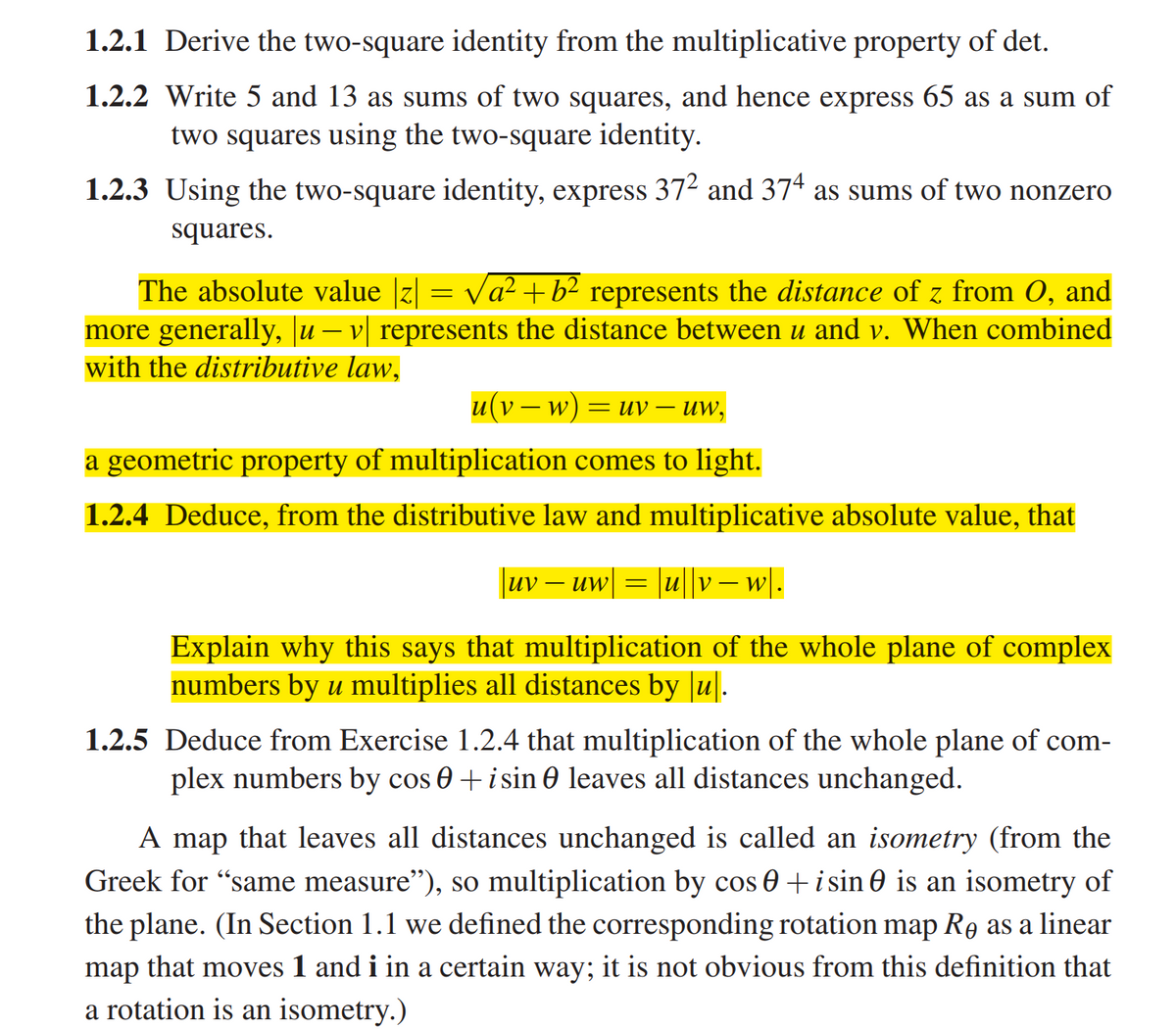The absolute value |z| = Va² +b² represents the distance of z from 0, and more generally, u – v| represents the distance between u and v. When combined with the distributive law, u(v – w) = uv – uw, a geometric property of multiplication comes to light. 1.2.4 Deduce, from the distributive law and multiplicative absolute value, that |uv – uw| : lu||v – w|. Explain why this says that multiplication of the whole plane of complex numbers by u multiplies all distances by |u|.
The absolute value |z| = Va² +b² represents the distance of z from 0, and more generally, u – v| represents the distance between u and v. When combined with the distributive law, u(v – w) = uv – uw, a geometric property of multiplication comes to light. 1.2.4 Deduce, from the distributive law and multiplicative absolute value, that |uv – uw| : lu||v – w|. Explain why this says that multiplication of the whole plane of complex numbers by u multiplies all distances by |u|.
Algebra & Trigonometry with Analytic Geometry
13th Edition
ISBN:9781133382119
Author:Swokowski
Publisher:Swokowski
Chapter10: Sequences, Series, And Probability
Section10.7: Distinguishable Permutations And Combinations
Problem 30E
Related questions
Question
100%
Please help with 1.2.4 (highlighted) for Modern ALgebra
Thankyou so much

Transcribed Image Text:1.2.1 Derive the two-square identity from the multiplicative property of det.
1.2.2 Write 5 and 13 as sums of two squares, and hence express 65 as a sum of
two squares using the two-square identity.
1.2.3 Using the two-square identity, express 372 and 37ª as sums of two nonzero
squares.
The absolute value |z| = va² +b² represents the distance of z from 0, and
more generally, |u – v| represents the distance between u and v. When combined
with the distributive law,
Z.
u(v – w)
= uv – Uw,
a geometric property of multiplication comes to light.
1.2.4 Deduce, from the distributive law and multiplicative absolute value, that
|uv – uw = |u||v – w|.
Explain why this says that multiplication of the whole plane of complex
numbers by u multiplies all distances by |u|.
1.2.5 Deduce from Exercise 1.2.4 that multiplication of the whole plane of com-
plex numbers by cos 0+ i sin 0 leaves all distances unchanged.
A map that leaves all distances unchanged is called an isometry (from the
Greek for "same measure"), so multiplication by cos 0 +isin 0 is an isometry of
the plane. (In Section 1.1 we defined the corresponding rotation map Re as a linear
map that moves 1 and i in a certain way; it is not obvious from this definition that
a rotation is an isometry.)
Expert Solution
This question has been solved!
Explore an expertly crafted, step-by-step solution for a thorough understanding of key concepts.
This is a popular solution!
Trending now
This is a popular solution!
Step by step
Solved in 2 steps with 2 images

Recommended textbooks for you

Algebra & Trigonometry with Analytic Geometry
Algebra
ISBN:
9781133382119
Author:
Swokowski
Publisher:
Cengage

Linear Algebra: A Modern Introduction
Algebra
ISBN:
9781285463247
Author:
David Poole
Publisher:
Cengage Learning

Algebra & Trigonometry with Analytic Geometry
Algebra
ISBN:
9781133382119
Author:
Swokowski
Publisher:
Cengage

Linear Algebra: A Modern Introduction
Algebra
ISBN:
9781285463247
Author:
David Poole
Publisher:
Cengage Learning